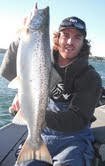|

Ontario Campgrounds
Ontario Salmon Fishing
|
 Early
Ice Pike n Pannies! Early
Ice Pike n Pannies!
 By:
Tyler Dunn
Tyler Dunn Guiding By:
Tyler Dunn
Tyler Dunn Guiding
First ice opportunities almost always has me
chasing panfish and pike on the lower parts of
the St. Mary’s River system. The small, shallow,
weedy bays that freeze first offer great cover
for pannies which creates the ideal grounds for
monster pike looking to gorge. The following are
a few techniques I use when ice fishing shallow
weedy bays for panfish and big pike.
Jig and Wait
When I use the term “jig and wait” the jig
refers to jigging panfish up and waiting refers
to targeting pike under a tip-up. Using these
two set-ups to thoroughly work a weed bed is a
deadly combination. For example if I am fishing
a deep pocket (10ft) in the middle of a shallow
bay (5ft) punching through the weeds looking for
perch with a buckshot spoon, I always have a
 smelt
on a quick strike rig hung along the edge of the
pocket or suspended on the weed edge adjacent to
the deepest water available. Baits can be hung
anywhere from just above the weeds to a foot or
two below the hole. This is one of my favourite
methods of picking apart a weed bed looking for
perch and crappie all the while waiting for a
true giant to take the bait on a tip-up. smelt
on a quick strike rig hung along the edge of the
pocket or suspended on the weed edge adjacent to
the deepest water available. Baits can be hung
anywhere from just above the weeds to a foot or
two below the hole. This is one of my favourite
methods of picking apart a weed bed looking for
perch and crappie all the while waiting for a
true giant to take the bait on a tip-up.
Run and Return
Run and return is a tactic I started using when
I first began to target fish in the weeds
through the ice. Basically instead of drilling
holes to never return, I will drill a line of
holes every 30 feet to my desired destination
and then turn around and fish the same holes
back to my starting point. Often times I found
perch to be scattered throughout the weed beds
only catching 1-2 from each hole unlike deep
basin areas that produce dozens of perch from
one hole when you find yourself on a school.
Another big reason I began doing this was the
fact I was almost always using a manual auger
and I wanted to cover as much water as possible
while cutting minimal holes.
 Use
Electronics Use
Electronics
Any angler that puts time in on the ice should
invest in a flasher. When fishing in shallow
bays it can be hard to decipher a fish from
weeds or worse a fish sitting in the weeds. Set
your gain on your flasher to the setting that
displays your lure as the smallest bar possible.
Once you have your gain set to the correct
setting and you’ve found your lure on the
screen, it is time to watch for any signs of a
fish moving up or down on the flasher screen.
Fish will be a red bar that you will see inside
of the weeds which show up as green bars.
Experiment with different baits and watch how
the fish react on your flasher. Once you find
one that is working consistently then begin to
start changing colours and try and fine tune
your presentation. Flashers will not only help
you catch more fish jigging but they also are a
key ingredient to tip-up success. Set your
quick-strike rig with precision over the weeds,
suspended over a hole in a weed bed or at any
exact depth you desire.
Prepare for Pike
Pan fishing can quite often become fast and
furious with action. That being said when a flag
goes off in the middle of a perch flurry, rarely
are anglers prepared to land the fish properly
if you do intend to release it. Since I practice
catch and release with my winter pike it was a
necessity to be prepared for a safe release
especially when fishing alone. My pike release
kit includes jaw spreaders, long needle nose
pliers, side cutters, measuring tape and of
course my camera. The kit comes with me anytime
I run to a flag.
|